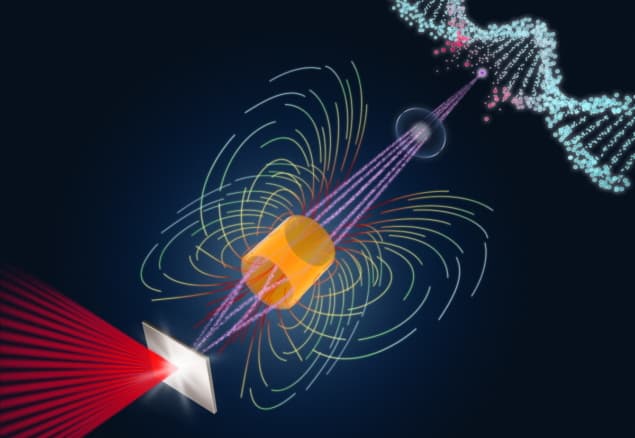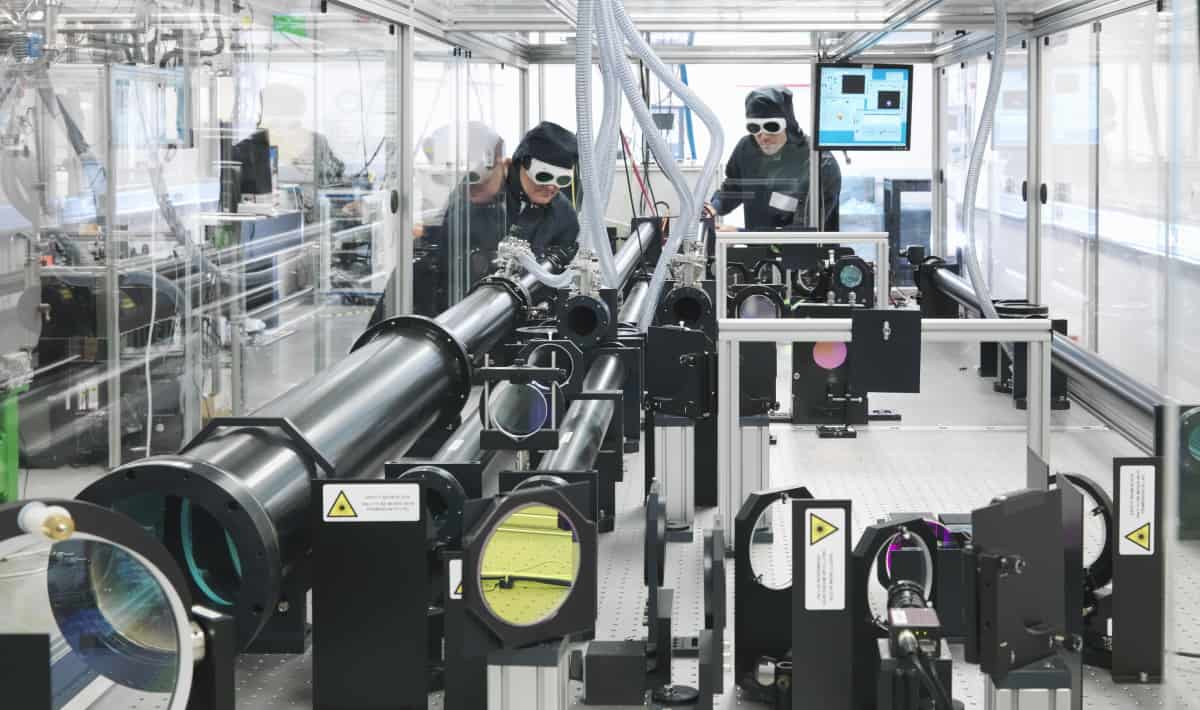
Laser plasma accelerators (LPAs) propel particles to high energies over short distances using intense, ultrashort pulses of laser light. These accelerators can supply high-quality particle beams for radiobiological studies that will help scientists better understand how radiation leads to DNA damage, and ultimately, help optimize particle-based cancer treatments.
Proton beams produced by laser plasma acceleration have a broad energy distribution, an exponentially decaying energy spectrum, and are bunched into particle pulses containing up to one trillion protons. This unique combination of beam properties makes proton LPAs suitable for ultrahigh-dose-rate radiobiology studies. Before researchers can conduct these studies, though, they must demonstrate that they can control LPA beam parameters.
To that end, Florian Kroll, a physicist at the Institute of Radiation Physics of Helmholtz-Zentrum Dresden-Rossendorf, his colleagues, and experts from OncoRay Dresden spent the last few years testing a sophisticated proton LPA platform. The platform has reliably displayed accelerator stability for two years, delivers model-compliant dose distributions, and in a pilot study in mice, demonstrated precise dose delivery and dosimetry.
A new laser plasma accelerator platform
Though strides in laser plasma acceleration have been made over the years, one of its primary challenges has persisted: laser plasma accelerators, and the particles that they accelerate, are difficult to stabilize and control.
The LPA method that Kroll and his colleagues implemented to improve this reliability relies on a high-power laser, tightly focused onto a thin (220 nm) plastic target.
“The intensity of the laser is so enormous that, when it impinges on the target, it immediately ionizes the target material, turning it into a plasma,” explains Kroll, first author on the resulting Nature Physics study.
Stripped from their atomic cores, the target’s electrons are pushed through the plasma by the laser. Some of the electrons, unable to escape the now positively charged target, form a “sheath” on the back side of the target and create a quasi-static electric field that “pulls” on the target ions. This field accelerates the ions into the mega-electronvolt (MeV) range.
The researchers optimized the shape of the resulting proton beam with several techniques, including a pulsed two-solenoid beamline that contains apertures and scatterers. To fine tune proton acceleration, they tailored the laser pulse shape temporally (the findings of a previous study demonstrated that the laser pulse’s “temporal shape” influences proton acceleration performance).
The LPA platform generates protons with a cut-off energy of up to 70 MeV and demonstrates stable accelerator performance, as well as daily delivery of prescribed volumetric dose distributions with percent-level margins.
In their accompanying radiobiological pilot experiments, the researchers irradiated human tumours on mouse ears using multi-shot LPA proton irradiation, clinical proton source irradiation, or standard 200 kV X-ray irradiation, comparing dosimetry and tumour control measures (the study design also included control and sham groups).
Although radiation-induced effects on tumour growth were observed, the focus of the pilot study was to demonstrate the feasibility of animal studies and to test the limits of dose delivery.
“We don’t want to speculate about the clinical applicability of laser-driven proton beams,” says Kroll. “In the early days of laser acceleration, many claims with respect to revolutionary, compact and cheap laser-driven therapy machines were made. In the end, everything turned out to be more complex than expected. Nevertheless, LPA machines have always been and will always be an interesting complementary accelerator technique to cyclotrons, synchrotrons and more.”
The future of LPA: FLASH and more
Some researchers note that the Nature Physics study is a breakthrough for the proton LPA community and that laser plasma accelerators are now ready for translational research. The study sets new standards for proton LPA sources, these researchers say, and paves the way for subsequent studies, such as those on the FLASH effect.

Intense radiation pressure enables selective acceleration of carbon ion beams
The FLASH effect occurs when a therapeutic radiation dose is delivered in a fraction of a second at an ultrahigh dose rate. In clinical settings, FLASH radiotherapy may reduce radiation damage in healthy tissues while remaining effective on tumours. Kroll notes that while the researchers were not trying to induce the FLASH effect in this study, they did find that single-shot sample irradiation “at full power” resulted in parameters that are expected to trigger the FLASH effect. As a result, future applications of their proton LPA platform may include verifying the FLASH effect with protons and investigating radiochemistry in the context of FLASH.
“[This study] was an amazing display of teamwork between technicians, engineers, physicists and biologists, all pulling in the same direction,” says Kroll. “We will continue to try answering radiobiological questions and look closer into the FLASH effect and its mechanisms. In parallel, we constantly strive for higher proton energies, particle numbers and source stability.”
